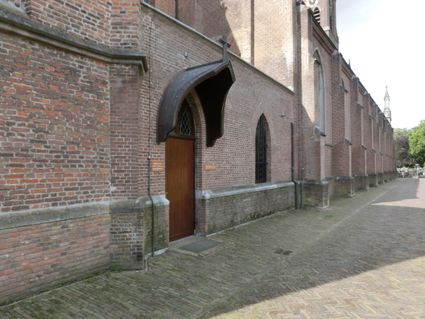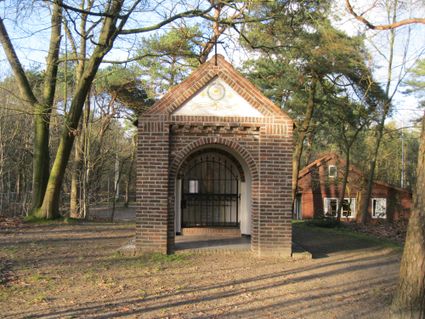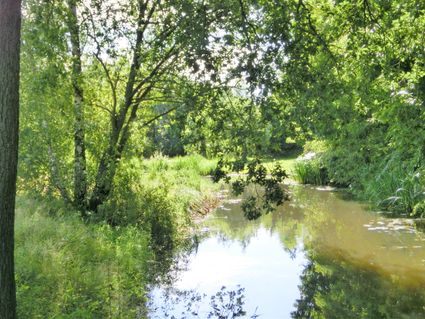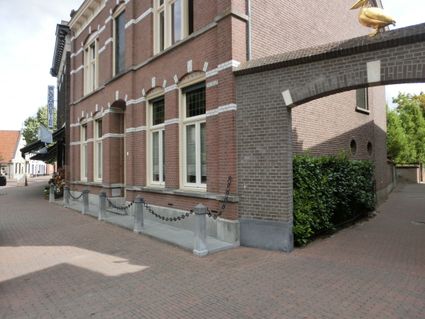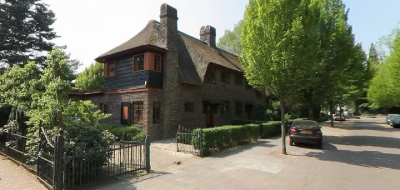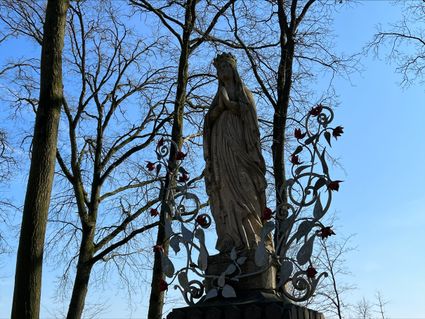Gehucht: Vossenberg
Clearing hamlet of Elsendorp. The former 'school with the Bible' of the hamlet Vossenberg, now in use as a residential house
The history of the Protestant hamlet of Vossenberg is inextricably intertwined with the reclamation of the Peel. Indeed, …
Clearing hamlet of Elsendorp. The former 'school with the Bible' of the hamlet Vossenberg, now in use as a residential house
The history of the Protestant hamlet of Vossenberg is inextricably intertwined with the reclamation of the Peel. Indeed, in the early 20th century, the large-scale reclamations opened up a flood of opportunities to cultivate new land, to work as a farmer or forester or to take a job with the Dutch Heath Society, which broke up the centuries-long isolation of the Peel area with drains, plantings and lots of manual labor. This attracted many people, including Northerners. These had a church in Veghel but those who lived near Elsendorp found this too far, they had to walk more than about 25 kilometers to go to church, and then back again. So in 1927, on the Vossenberg estate, owned by Mr. Groskamp, a Protestant church of its own was established. It had its own cemetery, rectory and the existing schoolroom was expanded into a public school, a "school with the Bible. Most members of the Protestant church congregation lived near their church and thus the hamlet of Vossenberg was formed. This hamlet is characterized by the straight roads and various architectural styles of the young Peel development and is well preserved. Few buildings have been added and the hamlet lies free in the green and undeveloped estate area.
Reclamation work in the Peel
The Dutch Heath Society, founded in 1888 was the largest reclamation company in Gemert-Bakel. It was a national organization with the goal of bringing wasteland such as the Peel under cultivation by order of the owners. Often the wasteland was brought into use for forestry. This was certainly the case in the Peel, where the lands of the Nederlandse Heidemaatschappij were incorporated into Houtvesterij de Peel. Small pieces of land were reclaimed by private individuals who often did turn it into pasture or arable land. Part of the reclamation work was the digging of water ditches to dewater the often wet area. The land was plowed and leveled and existing trees were cut down and the roots uprooted. Later, pines were planted for forestry. These activities still required a lot of human labor.
Children were also employed in the clearing work, as evidenced by a newspaper article in the "Zuidwillemsvaart," 21-3-1900, which talks about accelerated forest planting because of the approach of compulsory schooling, children aged 8-11 could now assist in planting the forests. The paper wonders if it would not be better if only boys over 12 could do this work. Most workers lived in the outlying villages, Bakel, Gemert, De Mortel, Handel and De Rips and sometimes had to walk miles to get to work. In 1920, the Wegschap de Peel was established with the task of making the Peel more accessible. This in imitation of a Water Board, it was a unique case in the Netherlands. The Gemertse Peel was sold in parts by the government and A.H. Groskamp bought the part the Vossenberg where he built a farm and a bungalow as a summer residence for him and his family. Grosman sold the farm in 1938 and it was rezoned into a few additional farms.
Sources:
S. Hoeymakers, Houtvesterij de Peel, 1986, Heemkundekring De Kommanderij, Gemert
S. Hoeymakers, Het Gouden Dorp, 1976, Harry Bek & Son Book and Offset Printing Company, Veghel


